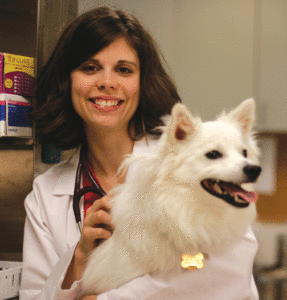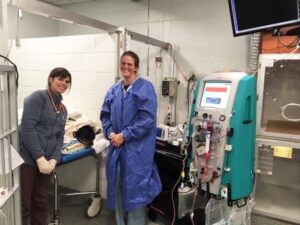-
Adopt
-
Veterinary Care
Services
Client Information
- What to Expect – Angell Boston
- Client Rights and Responsibilities
- Payments / Financial Assistance
- Pharmacy
- Client Policies
- Our Doctors
- Grief Support / Counseling
- Directions and Parking
- Helpful “How-to” Pet Care
Online Payments
Emergency: Boston
Emergency: Waltham
Poison Control Hotline
-
Programs & Resources
- Careers
-
Donate Now
 Shawn Kearns, DVM, DACVIM
Shawn Kearns, DVM, DACVIM![]()
ngell.org/internalmedicine
internalmedicine@angell.org
617-541-5186
Extracorporeal therapies (ECT) in veterinary medicine most often involve dialysis for acute kidney injury (AKI) patients and more recently therapeutic plasma exchange (TPE) or plasmapheresis for autoimmune diseases. While dialysis has been a known option for ethylene glycol ingestion for many years, not until recently have these advanced therapies been used for other accidental ingestions and overdoses. In human medicine, ECTs are used in ~0.1% of all reported poisonings. Many substances have a large safety margin, are safe when exposure is in isolation, or there may be medical means for treatment but ECT may be considered when this is not the case.
Deciding whether to consider dialysis or TPE for a toxicity should be based on several factors. Keeping in mind the metabolism of a substance may be altered depending on the quantity the patient ingested, the first question to ask is whether using advanced therapies will lead to a higher extraction rate than what the body may metabolize. If allowing the substance to be metabolized endogenously could be lethal or lead to significant or irreversible tissue damage, ECT should be a consideration. Second, determine whether the substance could cause a progressive deterioration in clinical status or depression of midbrain function leading to hypoventilation, hypothermia and hypotension. If the patient has a pre-existing condition that may impair drug or substance excretion, ECT may be an added tool along with other medical therapies. In veterinary medicine, a challenge in determining the benefit of ECT includes often not knowing the exact timing of exposure and/or the exact dose ingested.
Not all substances are amenable to clearance by dialysis or TPE. Mode of clearance therapy depends on the size of the molecule, the degree of protein binding and the volume of distribution. Typically only low molecular weight substances (10,000 daltons) that are less than 80% protein bound with a low volume of distribution (< 2L/kg) can be cleared with diffusion based dialysis. Machines that are capable of convection based dialysis can clear slightly larger molecules but the capacity is still for those < 40kDa. Special filters containing activated charcoal or other microporous material can be placed in tandem with dialyzer sets to increase the capture of molecules. Small molecules within the serum cross these membranes and become “trapped” within the microporous material. This ECT process is called hemoperfusion (HP). Usually HP is still limited to smaller molecular weight molecules, similar to dialysis, but the extraction rate may be increased when used together.
As the most abundant protein in the blood, albumin is responsible for the majority of non-specific binding to drugs and poisons. The complex of drugs and poisons with albumin creates a large molecule, typically > 67KDa. As a result, these cannot diffuse across most dialysis and hemofilters. Only free, unbound forms of the drug or poison can be removed. Therefore, for larger molecules that are highly protein bound (> 80%), TPE would be the primary consideration and this includes non-steroidal anti-inflammatory drug (NSAID) overdoses. For certain highly protein-bound substances, the degree of protein binding may be altered (lowered) when high doses are encountered, and in these instances, dialysis may be considered. Hemoperfusion can also aid in the removal of some highly protein bound toxins (< 90%) as the adsorbent competes with albumin for the binding. Albumin dialysis techniques can remove protein bound poisons indirectly via competitive binding to exogenous albumin in enriched dialysis, but these techniques are currently not used in veterinary medicine.
For any ECT, the clearance of a substances is only from the intravascular space. Therefore, for drugs that are lipophilic and have high protein binding, the distribution is preferentially outside the vascular space and may not be as amenable to ECT. Capturing lipophilic substances may be enhanced by single-pass lipid dialysis (SPLD) where a lipid solution is added to the dialysate to try to help draw out and clear more of the substance. This has been reported in dogs with ivermectin toxicosis that did not respond to traditional lipid treatment.
The majority of toxins cleared by ECT in veterinary medicine have been non-steroidal anti-inflammatory (NSAID) overdoses with up to 85% reduction in plasma concentrations reported. Although TPE +/- additional therapies (IV lipids), may not completely eliminate the risk of AKI with NSAID overdoses, it may reduce the magnitude in instances where total dose ingested are extremely high or the half -life is longer (ex: naproxen). Other reports of TPE and dialysis based therapies include treatment of metaldehyde, methotrexate, cyclosporine, and phenobarbital exposures.
Rarely endogenous toxins may pose significant enough health risk to warrant removal via extracorporeal therapies. High levels of serum bilirubin have been reported in humans and animals to cause neurologic signs. In addition, renal tubular injury may also occur from high bilirubin levels. TPE may be considered in cases with severe hyperbilirubinemia secondary to autoimmune hemolytic anemia leading to kernicterus and has been reported in dogs. TPE has also been reported for the treatment of one dog with hepatic encephalopathy prior to shunt correction. Ammonia levels in this case were decreased by ~50% and the patient improved clinically.
Use of ECT in veterinary medicine is a relatively new modality for treating intoxication. While medical therapies will remain the mainstay of treatment, in specific cases these advanced therapies should be considered.
References
- Ghannoum M, Roberts DM, Hoffman RS et al. Seminars in dialysis. Vol 27 (4) 2014 P 362-370
- Londono LA, Buckley GJ, Bolfer L et al. Clearance of plasma ivermectin with single pass lipid dialysis in 2 dogs. J Vet Emerg Crit Care 2017 Mar; 27 (2): 232-237.
- Rosenthal MG, Labato MA. Use of therapeutic plasma exchange to treat nonsteroidal anti-inflammatory drug overdose in dogs. J Vet Intern Med 2019 Mar-Apr; 33 (2): 596-602
- Culler CA, Reinhardt A, Vigani A. Successful management of clinical signs associated with hepatic encephalopathy with manual therapeutic plasma exchange. J Vet Emerg Crit Care 2020 May 30 (3): 312-317
- Heffner GG, Cavanagh A, Nolan B. Successful management of acute bilirubin encephalopathy in a dog with immune medicated hemolytic anemia. J Vet Emerg Crit Care. Sept 2019; 29 (5): 549-557.
- Tovar T, Deitschel S, Guenther C. The use of therapeutic plasma exchange to reduce serum bilirubin in a dog with kernicterus. J Vet Emerg Crit Care. July 2017; 27 (4): 458-464.
- Kicera-Temple K, Londono L, Lanaux TM et al. Treatment of massive naproxen overdose using therapeutic plasma exchange in a dog. Clin Case Rep. August 2019; 7 (8): 1529-1533
- Walton S, Ryan KA, Davis JL et al.Treatment of ibuprofen intoxication in a dog via therapeutic plasma exchange. J Vet Emerg Crit Care. July 2017; 27 (4): 451-457.
- Walton S, Ryan KA, Davis JL et al. Treatment of meloxicam overdose in a dog via therapeutic plasma exchange. J Vet Emerg Crit Care. July 2017; 27 (4): 444-450.
- Kjaergaard AB, Davis JL, Acierno MJ. Treatment of carprofen overdose with therapeutic plasma exchange in a dog. J Vet Emerg Crit Care. July 2018; 28 (4): 356-360.
- Teichmann-Knorm S, Doerfelt S, Doerfelt R. Retrospective evaluation of the use of hemodialysis in dogs with suspected metaldehyde poisoning (2012-2017): 11 cases. J Vet Emerg Crit Care. March 2020; 30 (2): 194-201.
- Basile JK and Vigani A. Treatment of phenobarbital intoxication using hemodialysis in two dogs. J Vet Emerg Crit Care. March 2020; 30 (2): 221-225.
- Fick ME, Messenger KM, Vigani A. Efficacy of a single session in-series hemoperfusion and hemodialysis in the management of carprofen overdose in two dogs. J Vet Emerg Crit Care. March 2020; 30 (2): 226-231.
- Pardo M, Lanaux T, Davy R. Use of charcoal hemoperfusion and hemodialysis in the treatment of methotrexate toxicosis in a dog. J Vet Emerg Crit Care. May 2018; 28 (3): 269-273.
- Tauk BS and Foster JD. Treatment of ibuprofen toxicity with serial charcoal hemoperfusion and hemodialysis in a dog. J Vet Emerg Crit Care. Nov 2016; 26 (6): 787-792.
